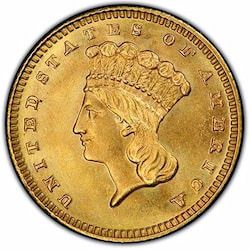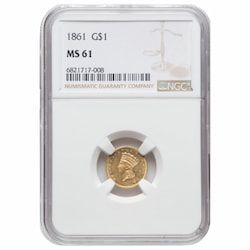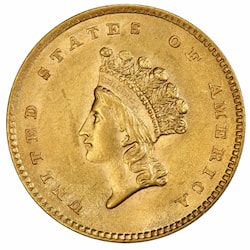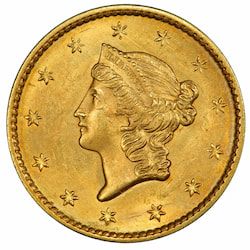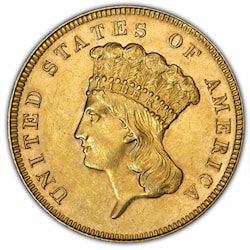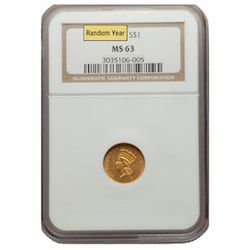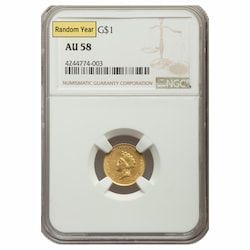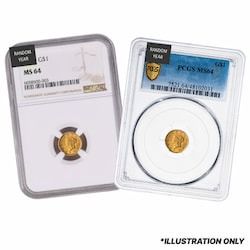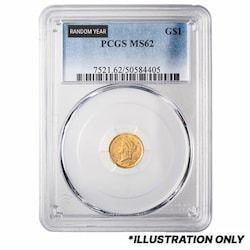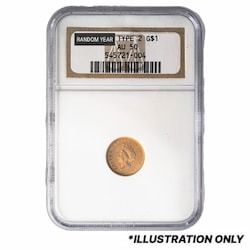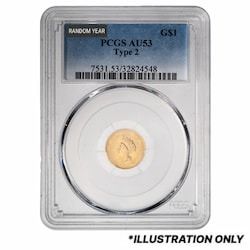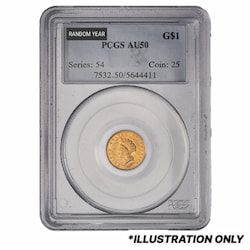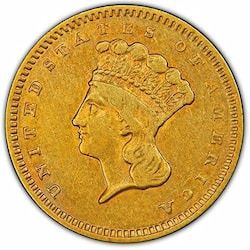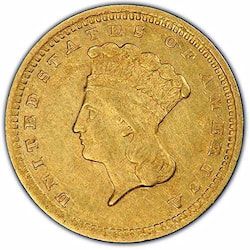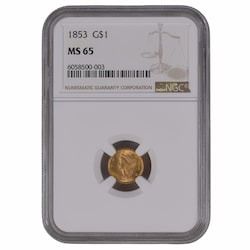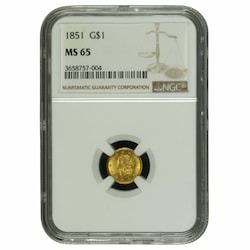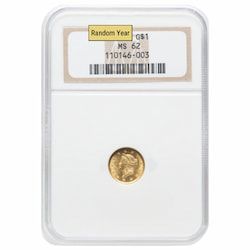$1 and $3 Gold Coins
The $1 and $3 Gold Coins are significant pieces of U.S. coinage. They were part of a broader range of American gold coins that circulated in the 19th century and represented the bustling economy after the California Gold Rush.
These coins remain highly coveted by collectors and investors today, not only for their intrinsic gold value, but also for their historical significance and craftsmanship that reflects an era of American prosperity.
History and Design
The $1 Gold Coin, first minted in 1849, was the smallest denomination of U.S. gold coins. It was introduced during the California Gold Rush, a time when there was a demand for smaller, more convenient denominations of gold currency.
The coin was designed by James B. Longacre, Chief Engraver of the U.S. Mint. The $1 Gold Coin went through three distinct design variations during its production, known as the Type 1, Type 2, and Type 3 designs.
Type 1 Liberty Head Gold Dollar
The obverse of the Type 1 features a portrait of Lady Liberty with a tiara inscribed with the word "LIBERTY." The design is encircled by thirteen six-pointed stars.
The reverse displays a wreath encircling the denomination and date with the inscription "UNITED STATES OF AMERICA" around the outer rim.
This design was only minted from 1849 to 1854. It was issued from different branches of the US Mint, including Philadelphia (no mint mark), the Charlotte Mint (C mint mark), Dahlonega (D), New Orleans (O), and the San Francisco Mint (S).
Types II and III - Indian Princess Gold Coin
In 1853, Congress passed a new Coinage Act approving the creation of a three dollar gold coin. The design, created again by James B. Longacre, was also adapted for the Gold Dollar coin and became the Type II gold dollar.
However, the adapted design for the Gold Dollar featured the Indian Maiden with a smaller head and feathered headdress, hence the moniker of "Small Head."
Only two years later, Longacre changed the dies for the gold dollar to match the same design used for the three dollar gold coin, featuring the Indian Princess with a larger head and headdress.
The Charlotte, San Francisco, Dahlonega and New Orleans Mints produced both these designs for a few years, but from 1871 on, only the Philadelphia Mint struck the Type III Indian Princess Large Head gold dollars.
Three Dollar Indian Princess
Even for that time, the $3 denomination was strange. The idea came following the silver three cent coins, which matched the price for postage stamps at the time. A coin worth 3 dollars would allow for the purchase of a hundred stamps, a reason that, on its own, did not convince.
Nevertheless, the three dollar piece coin was minted from 1854 to 1889. Most of the mintage was produced at the Philadelphia branch, but during the 1850s, other branch mints were also involved, including Dahlonega (D), New Orleans (O) and San Francisco (S).
The design, much like the Type III gold dollar, featured a Native American profile of Lady Liberty on the obverse design wearing a feathered headdress. The design is encircled by the words "UNITED STATES OF AMERICA" on the outer rim.
The reverse design shows an agricultural wreath surrounding the denomination "3 DOLLARS" and the mint year bellow. The wreath represents much of the country's abundant natural resources, including tobacco, wheat, corn and cotton.
The $3 Gold Coin was also designed by James B. Longacre and the design remained almost untouched from the first year to the last.
These three dollar pieces, though not a very popular denomination at the time, remain a treasured specimen of American coinage history.
Collectibility and Value
Condition: The condition and grading of both the $1 and $3 Gold Coins are crucial in determining their value. Coins in higher grades, particularly those in Mint State (MS60 to MS70), are highly desirable for their well-preserved details and original luster.
Investment: Both the $1 and $3 Gold Coins are composed of .900 fine gold, making them valuable not only as historical artifacts but also as investments. Their value is closely linked to the price of gold, making them stable and appreciating assets for investors looking to diversify their portfolios with historic gold coins.
Rarity: Certain dates and mint marks of the $1 and $3 Gold Coins are particularly rare, commanding higher premiums. Coins struck at the Southern mints of Dahlonega (D) and Charlotte (C) are among the most sought after due to their lower mintages and historical significance. The 1854-D $3 Gold Coin, in particular, is one of the rarest and most valuable in the series, with very few examples known to exist.
Legacy
The $1 and $3 Gold Coins are enduring symbols of 19th-century American numismatic artistry and innovation. Designed by James B. Longacre, these coins reflect the economic and cultural contexts of their time, from the California Gold Rush to the practical needs of everyday commerce.
Collectors and investors treasure these coins not only for their precious metal content but also for their historical significance and intricate designs. The legacy of the $1 and $3 Gold Coins continues to be celebrated, making them prized additions to any numismatic collection focused on American history and gold coinage.






